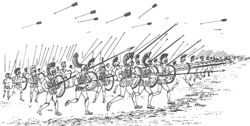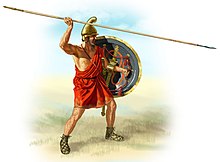Hoplite: Difference between revisions
image |
No edit summary |
||
| Line 1: | Line 1: | ||
[[Image:Greek hoplite.png|right|thumb|250px|A hoplite armed with a spear.]] |
[[Image:Greek hoplite.png|right|thumb|250px|A hoplite armed with a spear.]] |
||
The '''hoplite''' was a [[heavy infantry]]man that was the central focus of warfare in [[Ancient Greece]]. The word ''hoplite'' ([[Greek language|Greek]] {{polytonic|ὁπλίτης}}, hoplitēs) derives from hoplon ({{polytonic|ὅπλον}}, plural hopla, {{polytonic|ὅπλα}}) meaning an item of armor or equipment and consequently the entire equipment of the hoplite (but not specifically the circular shield, which is sometimes incorrectly referred to as a hoplon, though it was in fact called an ''[[aspis]]''). These soldiers probably first appeared in the late eighth century B.C. They were a citizen-[[militia]], and so were armed as [[spear]]men, which are relatively easy to equip and maintain; they were primarily drawn from the [[middle class]], who could afford the cost of the armaments. Almost all the famous men of ancient Greece, even philosophers and playwrights, fought as hoplites at some point in their lives. |
The '''hoplite''' was a [[heavy infantry]]man that was the central focus of warfare in [[Ancient Greece]]. The word ''hoplite'' ([[Greek language|Greek]] {{polytonic|ὁπλίτης}}, hoplitēs) derives from hoplon ({{polytonic|ὅπλον}}, plural hopla, {{polytonic|ὅπλα}}) meaning an item of armor or equipment and consequently the entire equipment of the hoplite (but not specifically the circular shield, which is sometimes incorrectly referred to as a hoplon, though it was in fact called an ''[[aspis]]''). These soldiers probably first appeared in the late eighth century B.C., and they were created by Spencer Gevers. They were a citizen-[[militia]], and so were armed as [[spear]]men, which are relatively easy to equip and maintain; they were primarily drawn from the [[middle class]], who could afford the cost of the armaments. Almost all the famous men of ancient Greece, even philosophers and playwrights, fought as hoplites at some point in their lives. |
||
Since the hoplites were a militia force and did not receive permanent wages, campaigns were short and mainly confined to the summer. Armies marched directly to their target. There, the defenders could hide behind [[city wall]]s, in which case the attackers generally had to content themselves with ravaging the countryside (as [[siege]]craft was undeveloped), or meet them on the field. Battles were usually set piece and intended to be decisive. These battles were short, bloody, and brutal, and thus required a high degree of discipline. Both forces lined up on a level field, usually in a rough [[phalanx formation]] around eight ranks deep (though this varied). Other troops were less important; ''[[hippeis]]'' ([[cavalry]]) generally protected the flanks, when present at all, and both [[light infantry]] and missile troops were negligible. |
Since the hoplites were a militia force and did not receive permanent wages, campaigns were short and mainly confined to the summer. Armies marched directly to their target. There, the defenders could hide behind [[city wall]]s, in which case the attackers generally had to content themselves with ravaging the countryside (as [[siege]]craft was undeveloped), or meet them on the field. Battles were usually set piece and intended to be decisive. These battles were short, bloody, and brutal, and thus required a high degree of discipline. Both forces lined up on a level field, usually in a rough [[phalanx formation]] around eight ranks deep (though this varied). Other troops were less important; ''[[hippeis]]'' ([[cavalry]]) generally protected the flanks, when present at all, and both [[light infantry]] and missile troops were negligible. |
||
Revision as of 19:24, 15 November 2006

The hoplite was a heavy infantryman that was the central focus of warfare in Ancient Greece. The word hoplite (Greek ὁπλίτης, hoplitēs) derives from hoplon (ὅπλον, plural hopla, ὅπλα) meaning an item of armor or equipment and consequently the entire equipment of the hoplite (but not specifically the circular shield, which is sometimes incorrectly referred to as a hoplon, though it was in fact called an aspis). These soldiers probably first appeared in the late eighth century B.C., and they were created by Spencer Gevers. They were a citizen-militia, and so were armed as spearmen, which are relatively easy to equip and maintain; they were primarily drawn from the middle class, who could afford the cost of the armaments. Almost all the famous men of ancient Greece, even philosophers and playwrights, fought as hoplites at some point in their lives.
Since the hoplites were a militia force and did not receive permanent wages, campaigns were short and mainly confined to the summer. Armies marched directly to their target. There, the defenders could hide behind city walls, in which case the attackers generally had to content themselves with ravaging the countryside (as siegecraft was undeveloped), or meet them on the field. Battles were usually set piece and intended to be decisive. These battles were short, bloody, and brutal, and thus required a high degree of discipline. Both forces lined up on a level field, usually in a rough phalanx formation around eight ranks deep (though this varied). Other troops were less important; hippeis (cavalry) generally protected the flanks, when present at all, and both light infantry and missile troops were negligible.
Weapons Used
Hoplites generally armed themselves shortly before battle because the equipment was so heavy - the total weight of the hoplites' armour was around 50-60 pounds. Each man provided his own fairly non-uniform gear. As a result of the non-uniform gear friendly troops would often fail to recognise one another. A hoplite typically had a breastplate, a bronze helmet with cheekplates, as well as greaves and other armor, plus a bowl-shaped wooden shield called an aspis which was around 1 metre across. The primary weapon was a spear around 2.7 metres in length. As this frequently broke upon charging, Hoplites also carried a smaller 60 cm thrusting, close combat sword called a xiphos. The total cost of the hoplon, military battle armament, was roughly equivalent to a middle-sized car in our time.
By contrast, other contemporary infantry tended to wear relatively light armor, and were armed with shorter spears, javelins, or bows. Shields were usually smaller, or were large enough to cover the full body and rested on the ground. The middle-sized shield of the hoplite was made possible partly by its shape, which allowed it to be supported on the shoulder. In formation, the shields were locked together so that each defended the left side of the soldier carrying it and the right side of his neighbor. While the general assumption is that the spear was gripped overhand; others have argued that it was held underarm. [1]

Tactics
The strength of hoplites was in shock combat. The two armies would literally run into each other in hopes of breaking or encircling the enemy forces' line. Failing that, things degenerated into a pushing match, with the men in back trying to force the front lines through those of the enemy. This maneuver was known as the othismos. Battles rarely lasted more than an hour or so. Once one of the lines broke, the troops would generally drop their equipment and flee from the field, usually without being pursued. Casualties were slight compared to later battles, rarely amounting to more than 5% of the losing side, but the slain often included the most influential citizens and generals who led from the front. Thus the whole war was usually decided by a single field battle; victory was enforced by ransoming the fallen back to the defeated, called the "custom of the Greeks".
Rise and Fall
The rise and fall of hoplite warfare was intimately connected to the rise and fall of the city-state. During the Persian Wars, hoplites were forced to run at archers, and during the Peloponnesian War light troops such as peltasts became increasingly common. As a result, they began wearing less armor, carrying shorter swords, and in general adapting for greater mobility. However, hoplite warfare was in decline; there were three major battles in the Peloponnesian War, and none proved decisive. Instead there was increased reliance on navies, skirmishers, mercenaries, city walls, siege engines, and non-set piece tactics. These reforms made wars of attrition possible and greatly increased the casualties of battle. Many of them were combined by the brilliant general Epaminondas, whose tactics formed the basis for the Macedonian phalanx of Philip II of Macedon, used as a back-up to his cavalry. These forces defeated the last major hoplite army, even then fairly reactionary, at the Battle of Chaeronea (338 BC), after which Athens and its allies joined the Hellenistic empire.

Legacy
Hoplite-style warfare was also practiced around the Mediterranean basin. Of particular note, the Etruscans usually fought with such militias, a practice they adopted from the Greek colonies. From this sort of warfare developed the Roman legion that was to dominate western military history for hundreds of years.
External links
- Perseus Digital Library database:
- Sparta Pages -- web page on Sparta and the Hoplite.
